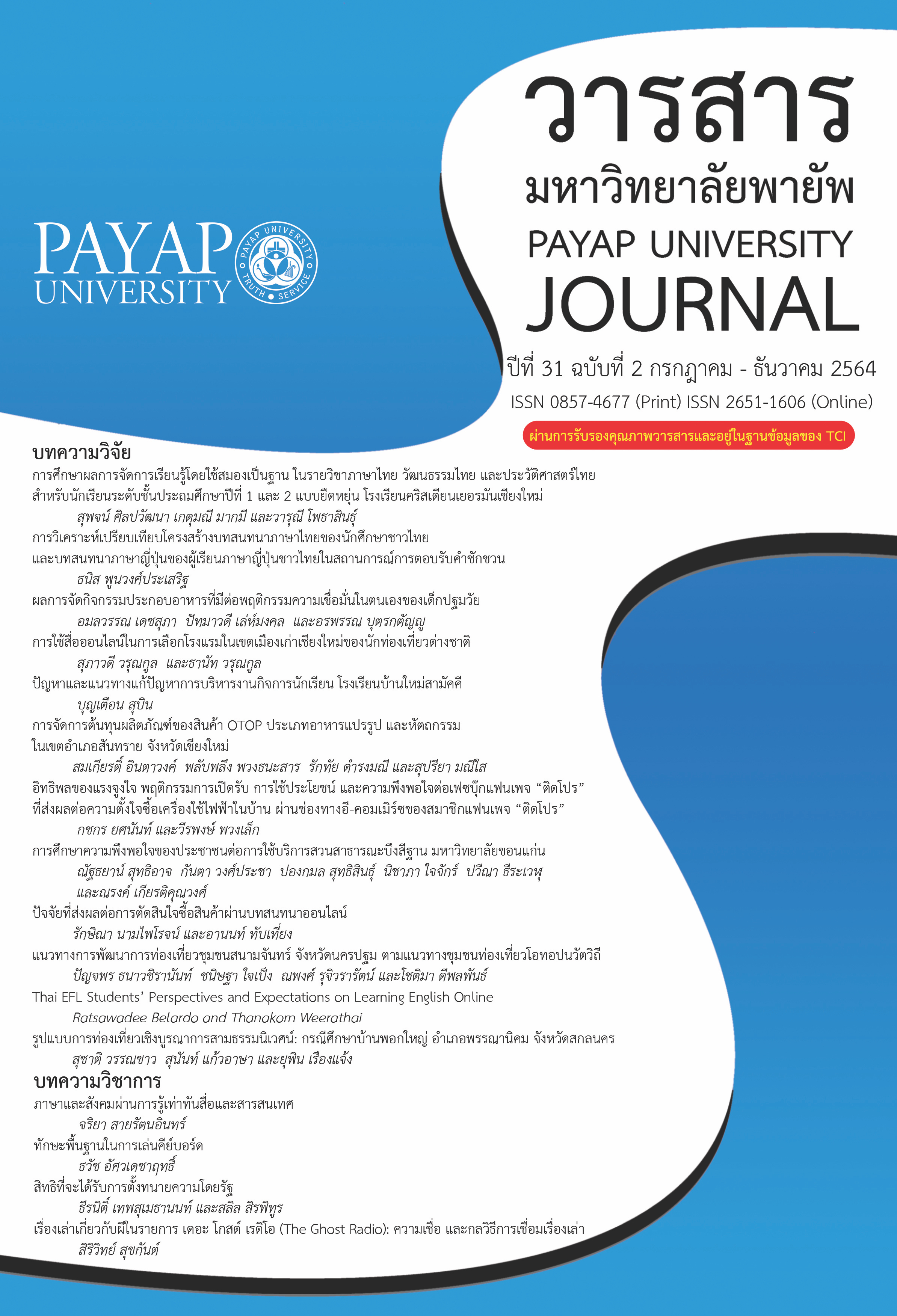การวิเคราะห์เปรียบเทียบโครงสร้างบทสนทนาภาษาไทยของนักศึกษาชาวไทยและบทสนทนาภาษาญี่ปุ่นของผู้เรียนภาษาญี่ปุ่นชาวไทยในสถานการณ์การตอบรับคำชักชวน
Main Article Content
บทคัดย่อ
การวิจัยนี้มีวัตถุประสงค์เพื่อศึกษาการถ่ายโอนทางวัจนปฏิบัติศาสตร์ของผู้เรียนภาษาญี่ปุ่นชาวไทย โดยวิเคราะห์เปรียบเทียบโครงสร้างบทสนทนาและลักษณะการใช้วัจนกรรมในสถานการณ์การตอบรับคำชักชวนไปรับประทานอาหารของกลุ่มนักศึกษาชาวไทยที่สนทนาด้วยภาษาไทย (TT) และกลุ่มผู้เรียนภาษาญี่ปุ่นชาวไทยที่สนทนาด้วยภาษาญี่ปุ่น (JT) กลุ่มละ 20 คู่ รวม 40 คู่ ทั้ง 2 กลุ่มเป็นนักศึกษามหาวิทยาลัยขอนแก่น ใช้วิธีการสุ่มตัวอย่างแบบเฉพาะเจาะจง เก็บข้อมูลด้วยการอัดเสียงบทสนทนาบทบาทสมมุติ ผลการศึกษา พบว่า<<ส่วนเปิดบทสนทนา>><<ส่วนชักชวน>>และ<<ส่วนปรึกษา>> เป็นส่วนที่ปรากฏบ่อยในบทสนทนาของทั้ง 2 กลุ่ม แต่เมื่อวิเคราะห์การเรียงลำดับวัจนกรรมในโครงสร้างบทสนทนาแต่ละส่วน พบความแตกต่างกันหลายประการ เช่น (1) TT มักเปิดบทสนทนาด้วยการเรียกขาน จากนั้นชักชวนคู่สนทนาทันที แต่ JT จะเรียกขาน และรอจังหวะให้คู่สนทนาตอบรับ (2) เมื่อถูกชักชวน TT มักจะไม่ตอบรับโดยทันที แต่จะถามรายละเอียดและเจรจาร่วมกับผู้ชักชวน แล้วจึงตอบรับ ส่วน JT มักตอบรับคำชักชวนทันที (3) TT ปิดท้ายบทสนทนาด้วยการทักทาย JT ส่วนใหญ่ไม่มีส่วนปิดบทสนทนา นอกจากนี้ทั้ง 2 กลุ่มยังมีลักษณะการใช้วัจนกรรมที่แตกต่างกัน เช่น (1) TT มักพูดปฏิเสธตรง ๆ แต่กลุ่ม JT มักจะหลีกเลี่ยงการพูดปฏิเสธ (2) TT มักใช้วัจนกรรมแสดงทัศนะเพื่อโน้มน้าวคู่สนทนา แต่กลับไม่พบการใช้วัจนกรรมนี้ในกลุ่ม JT จากผลการศึกษาสรุปได้ว่า ไม่พบการถ่ายโอนทางวัจนปฏิบัติศาสตร์ที่เด่นชัดในกลุ่ม JT ปัจจัยที่ทำให้ลักษณะการใช้ภาษาของทั้ง 2 กลุ่มแตกต่างกัน คือ ตำราเรียนของผู้เรียนภาษาญี่ปุ่นชาวไทย ความสามารถภาษาญี่ปุ่น และวัฒนธรรม ผลการศึกษาในครั้งนี้เป็นข้อมูลพื้นฐานที่จะช่วยชี้แนะประเด็นในเรื่องการถ่ายโอนทางภาษา ซึ่งอาจทำให้เกิดปัญหาในการสื่อสารข้ามวัฒนธรรม
Article Details
เอกสารอ้างอิง
A Corporation. (2549). มินนะ โนะ นิฮงโกะ 1. กรุงเทพฯ: สมาคมส่งเสริมเทคโนโลยี (ไทย-ญี่ปุ่น).
Austin, J. L. (1962). How to Do Things with Words. New York: Oxford University Press.
Canale, M. (1983). From communicative competence to communicative language pedagogy. In J. C. Richards & R. W. Schmidt (Eds.), Language and Communication (pp. 2-27). London: Longman.
Canale, M. & Swain, M. (1980). Theoretical Bases of Communicative Approaches to Second Language Teaching and Testing. Applied Linguistics. 1(1), pp. 1-47.
Jefferson, G. (1984). Transcript Notation. In J. M. Atkinson and J. Heritage (Eds.), Structures of Social Action: Studies in Conversation Analysis (pp.ix-xvi). Cambridge: Cambridge University Press.
Sacks, H., & Schegloff, E. A. (1973) Opening Up Closings. Semiotica, 8(4), pp. 289-327.
Sacks, H., Schegloff, E. A., & Jefferson, G. (1974). A Simplest Systematics for the Organization of Turn-Taking for Conversation. Language, 50(4), pp. 696–735.
Schegloff, E. A. (2007). Sequence Organization in Interaction: A Primer in Conversation Analysis 1. Cambridge: Cambridge University Press.
川口義一・蒲谷広・坂本恵 (2002) 「待遇表現としての「誘い」」『早稲田大学日本語教育研究』1号 pp. 21-30.
ザトラウスキー・ポリー (1993)『日本語の談話の構造分析―勧誘のストラテジーの考察』くろしお出版
クイシェンキアン (2018)「日本語とクメール語における勧誘の対照研究-勧誘の承諾の
会話に着目して-」大阪大学大学院言語文化研究科修士論文
筒井佐代 (2002) 「会話の構造分析と会話教育」『日本語・日本文化研究』12号 pp. 9-21.
中垣友江 (2014)「日本語とスワヒリ語における「勧誘」会話の対象研究:昼ごはんの
「勧誘の断り」の会話から」『日本語・日本文化研究』 24号 pp. 170-185.
鄭 在恩 (2009) 「日韓の勧誘ストラテジーについて」『言葉と文化』 10号 pp. 113-132.
浜田昌子・成田高宏 (2007)「タイ人日本語学習者の「申し出の断り」表現に見られる
「マイペンライ」の影響―ポジティブ・ポライトネスの表明として―」『小出記念日本語教育研究会論文集』15号 pp. 39-52.
ピナンソティクン ポラニー (2014) 「タイ語を母語とする日本語学習者の不同意表明に
おける語用論的特徴」『言語文化と日本語教育』47号 pp. 1-10.
藤森弘子 (1994)「日本語学習者に見られるプラグマティック・トランスファー―『断り』行為の場合―」『名古屋学院大学日本語学・日本語教育論集』1号 pp. 1-19.
ルンティーラ ワンウィモン (2004) 「タイ人日本語学習者の「提案に対する断り」表現
における語用論転移」『日本語教育』121号 pp. 46-55.


